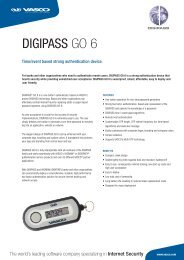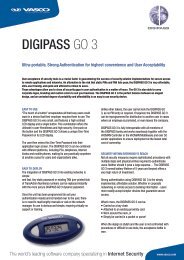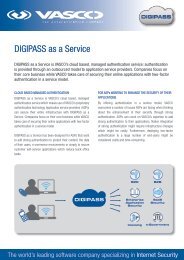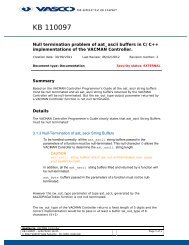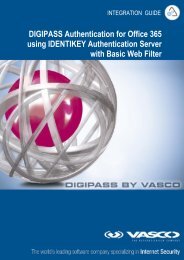Digipass Plug-In for SBR Administrator Reference - Vasco
Digipass Plug-In for SBR Administrator Reference - Vasco
Digipass Plug-In for SBR Administrator Reference - Vasco
Create successful ePaper yourself
Turn your PDF publications into a flip-book with our unique Google optimized e-Paper software.
<strong>Digipass</strong> <strong>Plug</strong>-<strong>In</strong> <strong>for</strong> <strong>SBR</strong> <strong>Administrator</strong> <strong>Reference</strong> Audit Messages<br />
16.2 Audit Message Fields<br />
Table 68: Audit Messages Fields<br />
Display Name Description<br />
Area Area of code/functionality in which the audit event occurred. Eg. “Active Directory search”.<br />
Operation Operation being attempted/processed when the audit event occurred.<br />
Error Code Standard error code.<br />
Error Message Fixed error message corresponding to ERROR_CODE.<br />
Error Details Full dump of 'error stack'.<br />
Source Location Location of source of audit message, typically IP address or host name.<br />
Server Location When the server itself is not the source of the audit message, this is the location of the<br />
server (IP/host name).<br />
Client Location When the client itself is not the source of the audit message, this is the location of the client<br />
(IP/host name).<br />
Version Full version string. Eg. “2.5.2.0045”.<br />
Data Source Type of data source. Eg. “File”, “Registry”.<br />
Data Source Location Specific location of data source. Eg. <strong>for</strong> a File, the path/filename.<br />
Configuration Details Breakdown of configuration settings.<br />
Outcome Outcome of an attempt to do something. Eg. “Success”, “Failure”, “Challenge”.<br />
Reason Generally a short phrase indicating a reason <strong>for</strong> a failure.<br />
Characteristics Space-separated list of keywords indicating characteristics of interest. Eg. <strong>for</strong> a connection<br />
attempt, keywords such as “SSL” , “TCP”, “IPv6” may be useful.<br />
User ID UserID. Can be in various <strong>for</strong>mats, unless it refers to a <strong>Digipass</strong> User Account UserID, when<br />
it must be exact (SAM-Account-Name).<br />
Domain Domain name (FQDN).<br />
Credentials What kind of credential was offered <strong>for</strong> a connection/login attempt. Eg. “Password”, “None”.<br />
Session ID Session identifier.<br />
Serial No <strong>Digipass</strong> Serial No.<br />
Application <strong>Digipass</strong> Application Name.<br />
Request ID Any request identifier(s). Eg. a RADIUS packet ID.<br />
Password Protocol The way in which a password is encoded. Eg. “PAP”, “CHAP”, “MS-CHAP1”, “MS-CHAP2”.<br />
<strong>In</strong>put Details Breakdown of request parameters/attributes.<br />
Action <strong>In</strong>tended action to take <strong>for</strong> a request received. Eg. “Ignore”, “Process”.<br />
Output Details Breakdown of response parameters/attributes.<br />
Policy ID Name of Policy used to handle a request.<br />
Mobile No Mobile phone no. <strong>for</strong> sending a text message.<br />
From Location from which something is moved. Eg. an Active Directory location.<br />
To Location to which something is moved. Eg. an Active Directory location.<br />
User Link Identification of user to which another user is linked.<br />
Message This is used where something external (eg. the MDC) returns a message <strong>for</strong> auditing.<br />
Expiration Date Value of an expiry date such as Grace Period.<br />
Quota Value of a quota such as Backup Virtual <strong>Digipass</strong> Uses Remaining.<br />
Local Authentication Whether Local Authentication was done or not.<br />
Back-End<br />
Authentication<br />
If Back-End Authentication was done, the Back-End Protocol used, otherwise “None”.<br />
© 2006 VASCO Data Security <strong>In</strong>c. 175




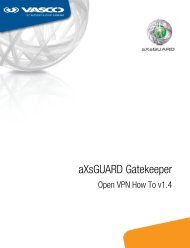
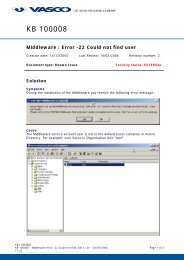
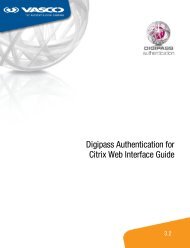
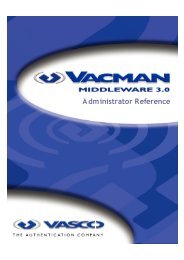
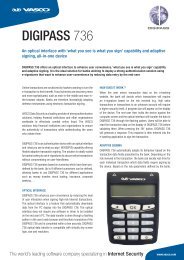
![KB [100006] - Vasco](https://img.yumpu.com/12539350/1/184x260/kb-100006-vasco.jpg?quality=85)

